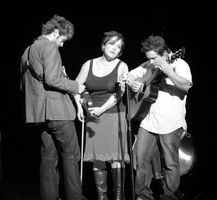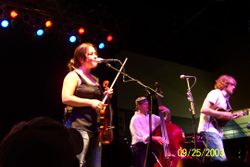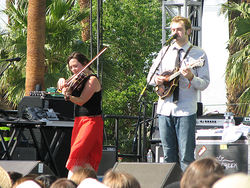Nickel Creek
| Nickel Creek | |
|---|---|
 Chris Thile, Sara Watkins, and Sean Watkins on the Farewell (For Now) tour in October 2007. |
|
| Background information | |
| Origin | Vista, California, USA |
| Genres | Progressive bluegrass Acoustic |
| Years active | 1989–2007 |
| Labels | Sugar Hill Records |
| Associated acts | Alison Krauss, Mutual Admiration Society, Punch Brothers, Switchfoot, Fiction Family |
| Website | www.nickelcreek.com |
| Past members | |
| Chris Thile Sara Watkins Sean Watkins |
|
Nickel Creek is an American acoustic music trio. Although the group's music has roots from bluegrass, the trio describe themselves as "progressive acoustic".[1] Nickel Creek consisted of three permanent members: Chris Thile (mandolin), Sara Watkins (fiddle) and her brother Sean Watkins (guitar). The trio have always recorded and toured with a bass player, but no bass player has ever been an official member of the band. Chris's father Scott Thile played bass with the group until 2000, followed by Byron House and Derek Jones. Mark Schatz has played bass regularly with the group since 2003.[2][3] In interviews, the band have stressed that they are not a bluegrass band but a band that "incorporates bluegrass into [their] music".[4] Nickel Creek has covered songs by Weezer, Radiohead, Pavement, Coldplay, Elliott Smith, Bob Dylan, The White Stripes, the Jackson Five and Britney Spears.[5]
Contents |
History
Early days: 1989–1999
Nickel Creek formed at That Pizza Place in Carlsbad, California in 1989 with Scott Thile, Chris's father, playing string bass.[6][7][8] The two families - the Watkinses and the Thiles - met after Sean Watkins and Chris Thile had mandolin lessons with the same teacher, John Moore.[8] Sara Watkins studied with Moore's bandmate, Dennis Caplinger.[8] At the start of Nickel Creek's history, Chris Thile played guitar and Sean Watkins played mandolin after deciding to switch.[6][8] The oldest of the Watkins children, Sean was only twelve years old at the time.[9] Upon forming, the band decided on a name which comes from a song by Byron Berline, Sara Watkins' fiddle instructor at the time.[10] Nickel Creek played many renowned bluegrass festivals throughout the '90s, but by the mid-'90s the three members of the band had to be home-schooled to accommodate their busy schedule. "The school wasn’t really cool with us missing the first two weeks of school and the last week of school," recalled Sara Watkins, "just because there were some really great festivals back East."[11] In the early days, Nickel Creek released two albums: Little Cowpoke (1993) and Here to There (1997).
Nickel Creek: 2000–2001
For Nickel Creek's next album release, the trio were in need of a producer, and Alison Krauss filled that position. Sara Watkins discussed their affiliation with Krauss in a 2000 interview.
| “ | We started discussing possibilities for a producer, but hadn't decided. We played a show at the Ryman, and we were opening for a band that included Tony Rice and Dan Tyminski. Alison Krauss and Ron Block were there. They came up and talked to us afterwards and were really enthusiastic about our show. So, we thought, 'WHAT IF...' Alison WAS kind of excited and just maybe she'd produce our CD. And she DID! Barry Poss of Sugar Hill asked her and we were just thrilled. We really needed vocal help. We've never been that insecure about our instrumentals, but vocals were another thing. They were weak points for us but are getting stronger, thanks to the work Alison has done with us. Alison just brought so much to the production of the CD. She was very good at spotting things that wouldn't last on a CD.[12] | ” |
Nickel Creek's eponymous 2000 release on Sugar Hill is widely considered their first major release. It is their most successful album to date, certified gold in 2002 and later platinum. Critics responded favorably, with Allmusic giving the album four and a half stars out of five.
Nickel Creek received two Grammy nominations: Best Bluegrass Album and Best Country Instrumental for "Ode to a Butterfly". The trio were also nominated at the CMA Awards for Best Vocal Group and the Horizon Award.[13] Nickel Creek's video for "The Lighthouse's Tale" was nominated a CMT "Flameworthy Video Award" for Group/Duo Video of the Year.[14] In addition to the Grammy nominations, they were named one of the "Five Music Innovators of the Millennium" by TIME Magazine in May 2000.[3]
To promote the album, Nickel Creek toured as a headlining and opening act in 2000 and 2001. The band opened eleven shows for Lyle Lovett in the summer of 2000, and played Austin City Limits in January 2001 with Dolly Parton. One month later Parton invited Nickel Creek to perform as her backup band at the 2001 Grammy Awards. The trio also had a spring tour with former Toad the Wet Sprocket lead singer Glen Phillips in a collaboration dubbed Mutual Admiration Society. A self-titled album was set to be released, but this was delayed until 2004. Nickel Creek also opened for Vince Gill and Amy Grant in the winter.[15][16] Shortly after Nickel Creek started touring, Scott Thile decided to leave the band due to lack of family time. Thile was briefly replaced by bassist Byron House. In March 2001 a new bassist, Derek Jones, joined the touring band.[16]
This Side: 2002–2004

In 2002 the band released their fourth album, This Side, produced by Alison Krauss. It was a major transition from their previous releases, the first two being purely bluegrass. Although the core influence of bluegrass remained throughout, many other genres such as indie rock and folk rock were present (the band covered Spit on a Stranger by Pavement, and Should've Known Better by Carrie Newcomer). When discussing the album in an interview from Barnes & Noble, Chris Thile described it:
| “ | We're not content to just go a little further. It's been three years since we recorded the first album, and I think people are forgetting that because all the attention has come in the last year. So the response is almost like, "Well, is it a concept record?" It certainly isn't; it's just who we are. People who ask that question have no concept of what we were like three years ago, before the first album came out. They also need to understand that [because of our youth], three years in our lives is a much larger percentage of how long we've lived. So there's going to be more change per year. We're growing and we're together all the time, so we're constantly trying to figure out new stuff.[17] | ” |
As with Nickel Creek, critics responded positively to This Side. Charles Spano of Allmusic said that "Thile and the Watkins siblings' originals, like the sleepy, subtle "Speak" and the darker "Beauty and the Mess," easily outdo the likes of folk-rockers Dave Matthews and Hootie & the Blowfish, while forging a new style to rejuvenate a genre that has always been a bit of a dark horse."[18]
This Side entered the Billboard 200 at #18 on the chart, and at #2 on the magazine's Top Country Albums chart.[19] The album was certified gold the following year of its release by the RIAA.[20] The success of This Side earned the group several awards, including a Grammy Award for Best Contemporary Folk Album.[3][7] The band was featured in Rolling Stone's "Best Of 2002" edition after the release of This Side.[3]
During the 2002 and 2003 This Side tour, Nickel Creek performed mainly as a headlining act, but also opened five shows for John Mayer in November 2002 in Upstate New York and New England,[21] and toured with Gillian Welch and David Rawlings earlier in the year.[22] In 2003, Nickel Creek appeared on the Béla Fleck and the Flecktones album Little Worlds.[23]
Why Should the Fire Die?: 2005
Three years following the release of This Side, Nickel Creek released their fifth album, Why Should the Fire Die?. This demonstrated more rock and pop influences, just as with This Side. Chris Thile discussed the band's genre and style in a 2005 interview from Jambase: "We actually feel like more than a bluegrass band that stretched out. We are a band that incorporates bluegrass into our music. There's been a problem in perception. 'Bluegrass band leaves the fold' (uses a news announcer voice). No, no, no, no, no. Actually, it's a band that incorporates a little bluegrass into whatever the hell kind of music they play."[4] Sean Watkins also said:
| “ | Well, actually, I think this record that we’re doing, it’s not moving farther away from bluegrass, I mean – we’ve always been far away from our bluegrass roots, I don’t think this record is much farther away than the last one. It’s just different. This record – I think it sounds more like we do I think than anything we’ve ever done. It’s a lot more rock I think than our first two, and there’s some stuff that’s farther out than we’ve gone, and there’s some stuff that’s very, that’s more roots–oriented. So I wouldn’t say that the whole thing is farther away.[9] | ” |
Why Should the Fire Die? debuted and peaked at #17 on the Billboard 200 and topped the Billboard bluegrass chart.[7]
In the summer of 2006 Nickel Creek appeared at numerous music festivals, including Bonnaroo,[24] High Sierra Music Festival, Austin City Limits,[25] SXSW,[26] Lollapalooza[27] and Star Fest.[28]
Farewell (For Now): 2006–2007
In late summer 2006, via Billboard and their official website, Nickel Creek announced that at the end of the year they would no longer be recording as a group and their tour, scheduled through 2007, would be their last for an indefinite period of time. According to Thile, "It's always been so natural, but lately it hasn't been quite as natural and we're running the risk of actually having to break up. We would rather leave it for a while, while it's still intact and healthy."[29]
Sean Watkins stated that all three members were ready to expand their musical horizons by experiencing real life again: "When you're on the road all the time and meet all these people who love your music, you can't always relate to them because stuff never happens to you. We're supposed to be writing songs that relate to other people... I need to be out there and having a different life than that. I am ready to write about real things again."[29]

In November 2006 Sugar Hill released Reasons Why: The Very Best, a compilation of selected studio tracks from Nickel Creek's three latest albums, as well as two previously unreleased tracks and all of the music videos from the trio's singles.[30]
Also that year, Nickel Creek planned the Farewell (For Now) Tour. It was originally intended to be called the Victory Lap Tour, but the band's managers thought that would make them sound "presumptuous and boastful".[31] The seven-month Farewell (For Now) Tour started in April 2007 and ended in November. In a statement at the start of the tour, Nickel Creek said that they "wanted to do this in a positive way and take that last lap before our break. We want to see our fans one more time and play with the musicians that have inspired us over the years."[32] The tour featured numerous guest appearances by Glen Phillips,[33][34] Jon Brion,[2] Fiona Apple,[35][36][37][38] Bruce Molsky,[39] Bela Fleck,[37] Tom Brosseau[37] and Tift Merritt, among others.
Nickel Creek planned to record a live DVD at the Ryman Auditorium in Nashville in November 2007 with special guests over the course of two nights.[40] However, that month it was announced instead that the "plans for the video shoot have been scrapped".[40] The performances still took place, and were the last before the group's hiatus.[41]
Looking back on the Nickel Creek experience, which spanned eighteen years, Sara Watkins said, "A lot of the other stuff will be special in the way that anything is special when you realize that it’s not going to be around forever...Nothing is going to be Nickel Creek except Nickel Creek. I’m not looking for anything to top this. It can’t be duplicated in my life."[42]
Awards and nominations
Wins
- 2000: IBMA Emerging Artist of the Year
- 2001: IBMA Instrumental Group of the Year
- 2003: Grammy Award for Best Contemporary Folk Album (This Side)
- 2006: CMT Top 10 Country Compilations of 2006 (Reasons Why: The Very Best)[30]
Nominations
- 2001: Grammy Award for Best Bluegrass Album (Nickel Creek)
- 2001: Grammy Award for Best Country Instrumental Performance ("Ode to a Butterfly")
- 2001: CMA Award for Best Vocal Group
- 2001: CMA Horizon Award
- 2005: Grammy Award for Best Contemporary Folk Album (Why Should the Fire Die?)
- 2005: Grammy Award for Best Country Instrumental Performance ("Scotch & Chocolate")
Discography
Albums
Compilations
|
Singles
|
References
- ↑ May, Caryn. "Nickel Creek dares to branch out". The Source Weekly. July 14, 2006. Retrieved January 20, 2008.
- ↑ 2.0 2.1 MacDonald, Patrick. "Bluegrass fans tell Nickel Creek "hurry back"". The Seattle Times. May 11, 2007. Retrieved March 2, 2008.
- ↑ 3.0 3.1 3.2 3.3 Nickel Creek. "Meet The Band". Nickel Creek. June 8, 2002. Retrieved December 1, 2007.
- ↑ 4.0 4.1 Cook, Dennis. "Chris Thile: Bringing In Some New Blood". JamBase. Retrieved January 17, 2007.
- ↑ "The Complete List of Non-Album Originals/Covers". nickelcreek.info. 2006-11-12. http://www.nickelcreek.info/forum/showthread.php?s=&threadid=6638. Retrieved 2007-10-13.
- ↑ 6.0 6.1 Quillien, Shay. "Hit-making Nickel Creek tries to catch its breath". Oakland Tribune. April 27, 2007. Retrieved February 23, 2008.
- ↑ 7.0 7.1 7.2 Rubin, Steven. "Grammys follow Nickel Creek as sound morphs". NC Times. December 14, 2005. Retrieved January 20, 2008.
- ↑ 8.0 8.1 8.2 8.3 Havighurst, Craig. "Nickel Creek: Newgrass Wunderkinder". Acoustic Guitar. August 2000. Retrieved March 2, 2008.
- ↑ 9.0 9.1 "Nickel Creek's Sean Watkins Blue Ridge Exclusive Interview". Blue Ridge. 2006. http://www.blueridgecountry.com/people/sean-watkins.html. Retrieved 2007-10-13.
- ↑ Seida, Linda. "Chris Thile Bio on JamBase". JamBase. Retrieved December 27, 2007.
- ↑ "Nickel Creek: Mandolin With No Country". Paste Magazine. 2006-08-01. http://www.pastemagazine.com/action/article/2051/nickel_creek?page=3. Retrieved 2007-10-13.
- ↑ "Sara Watkins". iBluegrass.com. 1999. Retrieved on October 13, 2007
- ↑ Jeckell, Barry A. "CMA Awards Add McBride, Tritt & More". Billboard. October 10, 2002. Retrieved February 3, 2008.
- ↑ Jeckell, Barry A. "Jackson, McBride, Keith Lead 'Flameworthy' Noms". Billboard. May 14, 2002. Retrieved February 3, 2008.
- ↑ Martens, Todd. "Grant, Gill Take Christmas On Tour". Billboard. September 21, 2001. Retrieved February 3, 2008.
- ↑ 16.0 16.1 Sara Watkins, Sean Watkins. "Nickel Creek Journals". Nickel Creek. August 17, 2000. Retrieved December 1, 2007.
- ↑ "Nickel Creek Tackle Bluegrass Tradition and Pop Innovation on This Side". Barnes & Noble. August 16, 2002. Retrieved November 11, 2007.
- ↑ Charles Spano. "This Side - Nickel Creek". Allmusic. Retrieved November 11, 2007.
- ↑ Martens, Todd/Ellis, Michael. "Nelly Topples The Boss At No. 1". Billboard. August 22, 2002. Retrieved February 3, 2008.
- ↑ "Nickel Creek Certified Gold". CMT. September 11, 2003. Retrieved February 19, 2008.
- ↑ Jeckell, Barry A. "Mayer Taps Randolph, Nickel Creek For Fall Tour". Billboard. October 25, 2002. Retrieved February 3, 2008.
- ↑ Sara Watkins. "Nickel Creek Journals". Nickel Creek. November 19, 2002. Retrieved December 1, 2007.
- ↑ Jeckell, Barry A. "Flecktones Prep Ambitious Triple 'Worlds'". Billboard. June 12, 2003. Retrieved February 3, 2008.
- ↑ "Bonnaroo 2006 Lineup Announced". CMT. February 1, 2006. Retrieved February 3, 2008.
- ↑ "Petty, Morrison, Nelson Top 'Austin City Limits' Bill". Billboard. May 18, 2006. Retrieved February 3, 2008.
- ↑ Cohen, Johnathan. "First Round Of Artists Confirmed For SXSW". Billboard. December 15, 2005. Retrieved February 3, 2008.
- ↑ Jeckell, Barry A. "Chili Peppers, Kanye, Wilco Lead Lollapalooza Lineup". Billboard. March 16, 2006. Retrieved February 3, 2008.
- ↑ Jeckell, Barry A. "Train, Pink lead Atlanta's Star Fest". Billboard. May 17, 2006. Retrieved February 3, 2008.
- ↑ 29.0 29.1 Hasty, Katie. "Nickel Creek Going On Hiatus, Just Not Yet". Billboard. August 28, 2006. Retrieved February 19, 2008.
- ↑ 30.0 30.1 "Top 10 Country Compilations of 2006". CMT. December 22, 2006. Retrieved February 19, 2008.
- ↑ Argyrakis, Andy. "Interview with Sean Watkins: Roots rock/alternative country combiners Nickel Creek say "farewell" for now LiveWire. August 8, 2007. Retrieved February 18, 2008.
- ↑ "Nickel Creek Prepares First Leg of Farewell Tour". CMT. Retrieved February 19, 2008.
- ↑ Jackson, Cory. "Sold out crowd says 'farewell' to Nickel Creek" Marshall Parthenon. Retrieved March 1, 2008.
- ↑ Dickens, Tad. "End of the road for Nickel Creek?". The Roanoke Times. November 2, 2007. Retrieved March 2, 2008.
- ↑ Hasty, Kate. "Apple, Nickel Creek Teaming For Tour". Billboard. May 18, 2007.
- ↑ Madison, Tjames. "Fiona Apple joins Nickel Creek's 'farewell' tour". LiveDaily. May 17, 2007. Retrieved March 2, 2008.
- ↑ 37.0 37.1 37.2 Kilgore, Kym. "Nickel Creek tours to the finish". LiveDaily. October 4, 2007. Retrieved March 2, 2008.
- ↑ Madison, Tjames. "Nickel Creek & Fiona Apple - 2007 collaborative & farewell Tour Dates (Summerstage)". Brooklyn Vegan. May 17, 2007. Retrieved March 2, 2008.
- ↑ "Bruce Molsky On Tour with Nickel Creek". Compass Records. October 18, 2007. Retrieved February 3, 2008.
- ↑ 40.0 40.1 John. "Nickel Creek - no DVD after all". The Bluegrass Blog. November 7, 2007. Retrieved November 11, 2007.
- ↑ Dollar, Steve. "Putting the 'Blue' Back in Bluegrass" The New York Sun. February 19, 2008. Retrieved February 23, 2008.
- ↑ "Bluegrass group Nickel Creek says farewell (for now)". Go to Reno Tahoe. April 2007. Retrieved February 19, 2008.
External links
- Nickel Creek's official site
- Official Merchandise Store
- Nickel Creek on Whole Wheat Radio
- Archived Audio Featured on show 165 of WoodSongs Old-Time Radio Hour
- NewMusicBox cover: Chris Thile in conversation with Frank J. Oteri, October 27, 2008 (includes video)
|
||||||||||||||